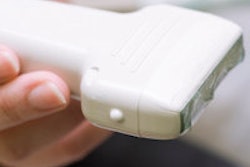For screening breast ultrasound studies, can sonographers deliver a performance comparable to that of radiologists? Turns out they can, according to research presented at the recent RSNA 2013 meeting in Chicago.
A team of researchers from Memorial Sloan-Kettering Cancer Center found that handheld screening breast ultrasound in the hands of experienced sonographers yielded a similar cancer detection rate and positive predictive value to the reported performance of physician-performed ultrasound screening programs in the literature.
"Screening breast ultrasound performed by experienced [sonographers] is a feasible alternative to a physician-based program and reduces radiologists' time and cost," said Dr. Janice Sung. She presented the group's findings on behalf of lead author Dr. Glenys Da Costa.
While a number of studies have described the success of physician-based breast ultrasound screening in high-risk patients for detecting mammographically occult breast cancers, these programs have limitations. These studies are time-consuming for physicians, they are operator-dependent, and they have low reimbursement, Sung said.
Sonographer-performed screening
Less information is available in the literature regarding sonographer-based ultrasound screening programs and their cancer yield, especially for women who are at average or intermediate risk, Sung said. As a result, the researchers sought to assess the added cancer detection yield, positive predictive value, and negative predictive value of a sonographer-performed handheld screening breast ultrasound program that included average- to medium-risk patients.
The team retrospectively reviewed 916 consecutive women who underwent screening breast ultrasound between October 2011 and March 2013. Electronic medical records were reviewed for patient age at time of ultrasound, breast density on mammography, and the presence of any additional risk factors for breast cancer, she said.
All ultrasounds were performed by an experienced breast sonographer. If the study was normal, a representative image was taken from each quadrant in each breast. Definitively benign findings such as cysts were not imaged, but any finding the sonographer thought was indeterminate or suspicious was then brought to the attention of the overseeing breast radiologist, who performed a targeted ultrasound prior to giving a final BI-RADS assessment, Sung said.
The study population had a median age of 53 years (range, 21-84 years); 60% of the women were either peri- or postmenopausal. Of the 80% of patients who had an additional risk factor, 59% had a family history of breast cancer in any relative, 30% had a personal history of breast cancer, and 10% had a prior history of a high-risk lesion.
Most of these screening ultrasounds were performed after New York state legislation required patient notification of breast density, Sung noted. Seventeen percent of patients had extremely dense breast tissue and 15% had heterogeneously dense breast tissue.
The researchers tracked the number of recommendations for biopsy, as well as short-term interval follow-up, the number of cancers detected, and the number of interval cancers.
Recommendations
Overall, 93% of the studies were considered to be normal with a BI-RADS 1 or BI-RADS 2 assessment. Short-term interval follow-up was recommended in 2% of studies, and biopsy was recommended in 5%.
Follow-up data -- which included a follow-up mammogram, breast MR, or another breast ultrasound -- were available in 55% of the normal cases.
Among the 43 women who had been given biopsy recommendations, biopsy was subsequently performed in 39. Benign pathology was found on percutaneous biopsy in 34 (87%) of these 39 cases, while two high high-risk lesions and three cancers were detected, for a positive predictive value of 8% in biopsied patients.
The false-positive rate of 4% was within the range previously reported in the literature for physician-based breast ultrasound screening programs, Sung said. Of the 34 benign lesions, the most common were fibroadenoma. The two high-risk lesions were one atypical lobular hyperplasia and one capillary lesion. Both yielded benign pathology at the time of subsequent surgical excision, she said.
Cancer detection
The three cancers detected during the study period represented an overall cancer yield of 3.3 per 1,000, which increased to 4.4 per 1,000 if only women with heterogeneously or extremely dense breasts were included. That figure is also within the range reported in the literature for physician-based breast ultrasound screening programs, she said.
The patients were diagnosed with cancer when they were between 39 and 64 years old, and all cancers were clinically important, small, and early stage. These cancers consisted of one invasive ductal cancer, one invasive lobular cancer, and one invasive mammary cancer with a mean size of 1.2 cm. All were in patients with heterogeneously dense breasts.
Overall positive predictive value was 7%, which is also within the range previously reported in the literature for physician-controlled screening programs, Sung said.
Interval cancers
There were three interval cancers, however. The first patient had a 0.9-cm mass that represented invasive ductal carcinoma and was palpable four months after the initial breast screening ultrasound. The second, a 1.8-cm invasive ductal carcinoma, presented with a palpable abnormality five months after the initial negative screening ultrasound. The third patient had a 1.4-cm invasive ductal carcinoma that was palpable, Sung said.
"This lesion had initially received a BI-RADS 3 recommendation because of the mixed echogenic mass that was thought to correspond to a stable mammographic finding," she said.
Short-term interval follow-up
As for the short-term interval follow-up group, the 2% recommendation rate was far lower than what has been reported in the literature, "largely probably due to the fact that we do not image findings that were considered definitively benign," she said.
Follow-up was obtained in 13 (81%) of these patients. In 11 of the 13, the finding was stable, decreased, or resolved. An increase was seen in two patients, one of whom had the cancer with the initial BI-RADS recommendation described above; the second had a lesion that was biopsied and found to be fibroadenoma.
"Handheld screening breast ultrasound performed by experienced sonographers demonstrates a similar cancer detection rate and positive predictive value to that reported for physician-performed ultrasound screening programs," Sung concluded.




















